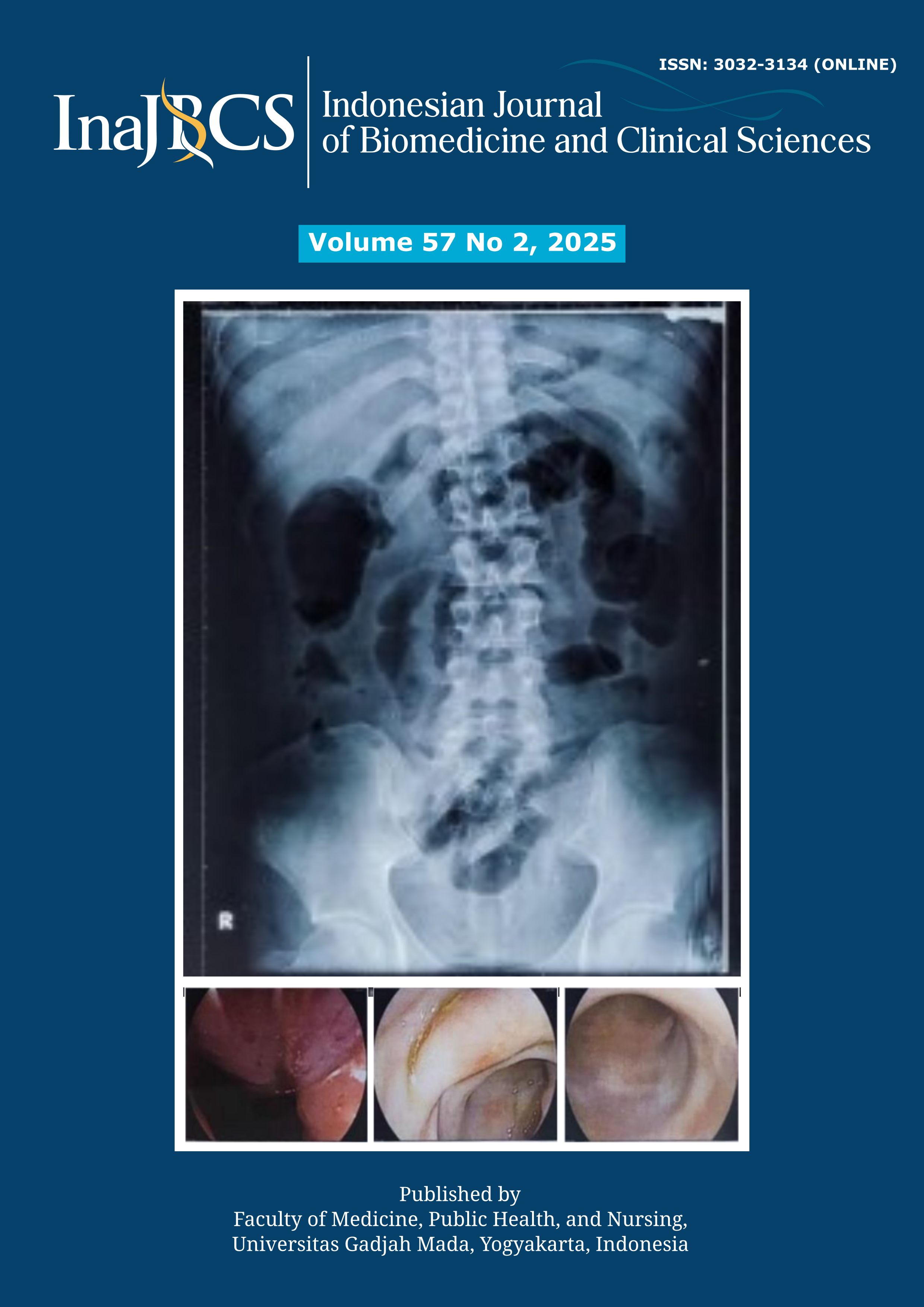The activity antibiofilm of betadine leaf (Jatropha multifida Linn) juice on urinary catheters
Abstract
Biofilm formation can reduce the efficacy of antibiotics against pathogenic microorganisms. Flavonoids are proven to have antibiofilm activity. Betadine leaf (Jatrophas multifida Linn) contains abundant flavonoids. This study aimed to evaluate the biofilm activity of the betadine leaf juice on urinary catheters. Biofilm forming Escherichia coli was isolated from a urinary catheter. The betadine leaf juice was prepared by harvesting, washing, drying, juicing, centrifuging, and sterilizing the juice. Phytochemical analysis was performed to identify the presence of steroids, alkaloids, flavonoids, and phenols. Biofilm and antibiofilm assays were conducted by incubating thioglycolate medium with varying concentrations of the betadine leaf juice and E. coli suspension, with bacterial growth and biofilm formation assessed based on turbidity observations. Alkaloids, steroids, flavonoids, and phenolic compounds have been found in the sterilized betadine leaf juice. Bacterial growth was observed in all tubes containing different dilutions of the betadine leaf juice. However, turbidity levels increased as the juice concentration decreased. Additionally, the weight of the urinary catheter was significantly greater in tubes with lower juice concentrations (p=0.02). In conclusion, the J. multifida Linn leaf juice has potential antibiofilm activity against E. coli in urinary catheters.
References
Gunardi WD, Karuniawati A, Umbas R, Bardosono S, Lydia A, Soebandrio A, et al. Biofilm-producing bacteria and risk factors (gender and duration of catheterization) characterized as catheter-associated biofilm formation. Int J Microbiol 2021; 2021:8869275.
https://doi.org/10.1155/2021/8869275
Sirijant N, Sermswan RW, Wongratanacheewin S. Burkholderia Pseudomallei resistance to antibiotics in biofilm-induced conditions is related to efflux pumps. J Med Microbiol 2016; 65(11):1296-306.
https://doi.org/10.1099/jmm.0.000358
Sharma G, Sharma S, Sharma P, Chandola P, Dang S, Gupta S, et al. Escherichia coli biofilm: development and therapeutic strategies. J Appl Microbiol 2016; 121(2):309-319.
https://doi.org/10.1111/jam.13078
Anggita D, Abdi DA, Desiani V. Efektifitas ekstrak daun dan getah tanaman jarak Cina (Jatropha multifida L.) sebagai antibakteri terhadap pertumbuhan bakteri Staphylococcus aureus secara in vitro. Window of Health: J Kes 2018; 1(1):29-33.
https://doi.org/10.33096/woh.v1i1.556
Liana Y, Utama YA. Efektifitas pemberian ekstrak daun betadine (Jatropha muitifida Linn) terhadap ketebalan jaringan granulasi dan jarak tepi luka pada penyembuhan luka sayat tikus putih (Rattus norvegicus). J Ked Kes 2018; 5(4):114-23.
https://doi.org/10.32539/JKK.v5i3.6313
Rusdy H, Damanik DH. Antibacterial activity of betadine (Jatropha multifida L.) stem extract on Pseudomonas aeruginosa growth in vitro. F1000Res 2024; 11:1222.
https://doi.org/10.12688/f1000research.123777.2
Kinasih LK, Nabahan I, Erawati S, Simanjuntak RNM. Effectivity of Jatropha multifida L. leaves extract as antibacterial on Streptococcus mutans using in vitro testing methods. Biomed J Indon 2021; 7(2): 415-21.
https://doi.org/10.32539/bji.v7i2.384
Harliananda N, Halimatussakdiah H, Amna U. Analisis kualitatif senyawa metabolit sekunder daun betadin (Jatropha multifida L.). QUIMICA: J Kim Sains Ter 2019; 1: 5-10.
Melander RJ, Basak AK, Melander C. Natural products as inspiration for the development of bacterial antibiofilm agents. Nat Prod Reports 2020; 37: 1454-77.
https://doi.org/10.1039/D0NP00022A
Matilla-Cuenca L, Gil C, Cuesta S, Rapun-Araiz B, Ziemyte M, Mira A, et al. Antibiofilm activity of flavonoids on staphylococcal biofilms through targeting BAP amyloids. Scie Reports 2020; 10(1):18968.
https://doi.org/10.1038/s41598-020-75929-2
Mandal SM, Dias RO, Franco OL. Phenolic compounds in antimicrobial therapy. J Med Food 2017; 20: 1031-1038.
https://doi.org/10.1089/jmf.2017.0017
Soleimani M, Arzani A, Arzani V, Roberts TH. Phenolic compounds and antimicrobial properties of mint and thyme. J Herb Med 2022; 36: 100604.
https://doi.org/10.1016/j.hermed.2022.100604
Danquah CA, Minkah PAB, Agana TA, Moyo P, Tetteh M, Junior IOD, et al. Natural products as antibiofilm agents. In: Focus on bacterial biofilms. IntechOpen, https://www.intechopen.com/chapters/81824 (2022, accessed 27 August 2024).
Skogman ME, Kanerva S, Manner S, Vuorela PM, Fallarero A. Flavones as quorum sensing inhibitors identified by a newly optimized screening platform using Chromobacterium violaceum as reporter bacteria. Mol 2016 Sep 10;21(9):1211.
https://doi.org/10.3390/molecules21091211
Hakiki D. Efektivitas flavonoid kulit manggis (Garcinia mangostana L) sebagai anti biofilm bakteri Enterococcus faecalis [Thesis]. Surabaya: Universitas Airlangga; 2015.
Yunita L. Uji aktivitas antibakteri fraksi daun betadine (Jatropha muitifida Linn) terhadap bakteri Staphylococcus aureus ATCC 25923 secara in vitro. J Kes 2016; 11: 218.
Conversation S. Jatropha multifida. https://www.socfindoconservation.co.id/plant/752 (2023, accessed 28 January 2025).
Senou M, Lokonon JE, Abissi EO-TR, Agbogba F, Dehou R, Mèdoatinsa E, et al. Antibacterial activity and toxicity of the sap and aqueous extract of the leaves of Jatropha multifida Linn. JBM 2022; 10: 171-82.
https://doi.org/10.4236/jbm.2022.107013
Luliana S, Riza H, Indriyani EN. The effect of extraction method on total phenolic content and antioxidant activity of salam leaves (Syzygium polyanthum) using DPPH (1,1-Diphenyl-2-Picrylhidrazil). MOT 2019; 24: 72-6.
https://doi.org/10.22146/mot.33955
Yan K, Cheng XJ, Bian GL, Gao YX, Li DQ. The influence of different extraction techniques on the chemical profile and biological properties of oroxylum indicum: multifunctional aspects for potential pharmaceutical applications. Evid Based Complement Alternat Med. 2022 Sep 19;2022:8975320.
https://doi.org/10.1155/2022/8975320
Dhanani T, Shah S, Gajbhiye NA, Kumar S. Effect of extraction methods on yield, phytochemical constituents and antioxidant activity of Withania somnifera. Arab J Chem 2017; 10: S1193-9.
https://doi.org/10.1016/j.arabjc.2013.02.015
Noranizan M, Pean LF, Li JW, Aadil RM, Ahmad T, Rosli SZ, et al. Impact of juice extraction method on the physicochemical, functional, and sensory properties of Sabah snake grass (Clinacanthus nutans) juice mix. Int Food Res J 2020; 27(5): 835-45.
Zou Z, Potter RF, McCoy WH 4th, Wildenthal JA, Katumba GL, et al. Coli catheter-associated urinary tract infections are associated with distinctive virulence and biofilm gene determinants. JCI Insight. 2023 Jan 24;8(2):e161461
https://doi.org/10.1172/jci.insight.161461
Survey on biofilm production and presence of attachment factors in human uropathogenic strains of Escherichia coli | Jundishapur Journal of Microbiology | Full Text, https://brieflands.com/articles/jjm-13108 (accessed 27 August 2024).
Naghmeh MB & Javadmakoei S. Survey on biofilm production and presence of attachment factors in human uropathogenic strains of Escherichia coli. Jundishapur J Microbiol 2017; 10(6): 13108
https://doi.org/10.5812/jjm-13108.
Fattahi S, Kafil HS, Nahai MR, Asgharzadeh M, Nori R, Aghazadeh M. Relationship of biofilm formation and different virulence genes in uropathogenic Escherichia coli isolates from Northwest Iran. GMS Hyg Infect Control 2015; 10: Doc11.
Fitria A, Nugraha AT, Meliani Y, Choiriah A. The bactericidal and antibiofilm activity of stem bark of Jatropha multifida L. against Staphylococcus aureus and MRSA. J Sci Data Anal 2018; 18(1): 42-55.






